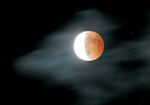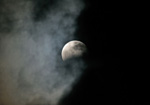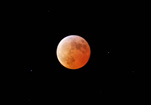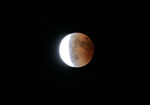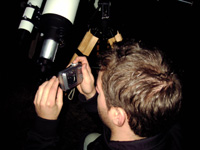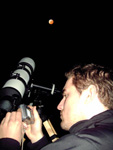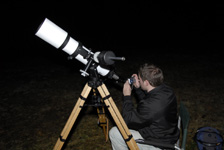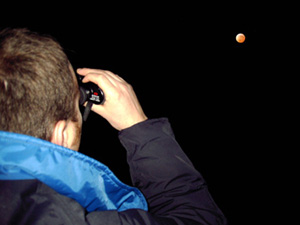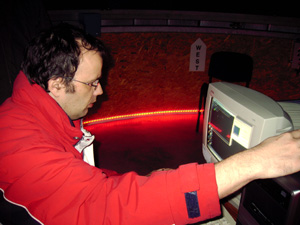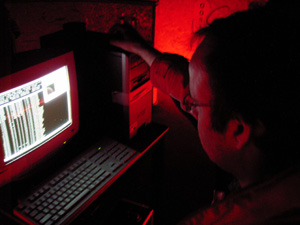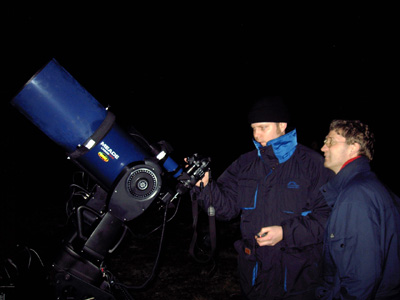
TOTAL LUNAR ECLIPSE
MARCH 3-4, 2007
On Saturday 3 and Sunday 4 March 2007, the full Moon passed through the Earth's
shadow, producing a total lunar eclipse for skywatchers throughout Asia, Australia, Europe, Africa and the
Americas. In The Netherlands and Belgium Astronet in cooperation with the Dutch
Copernicus Public Observatory, Belgian Mira Public
Observatory, Spanish Serviastro and Astroforum.nl organized a live webcast of the event.
Our live webcast was followed by more than 439,500 vistors!
IMAGES OF THE TOTAL LUNAR ECLIPSE
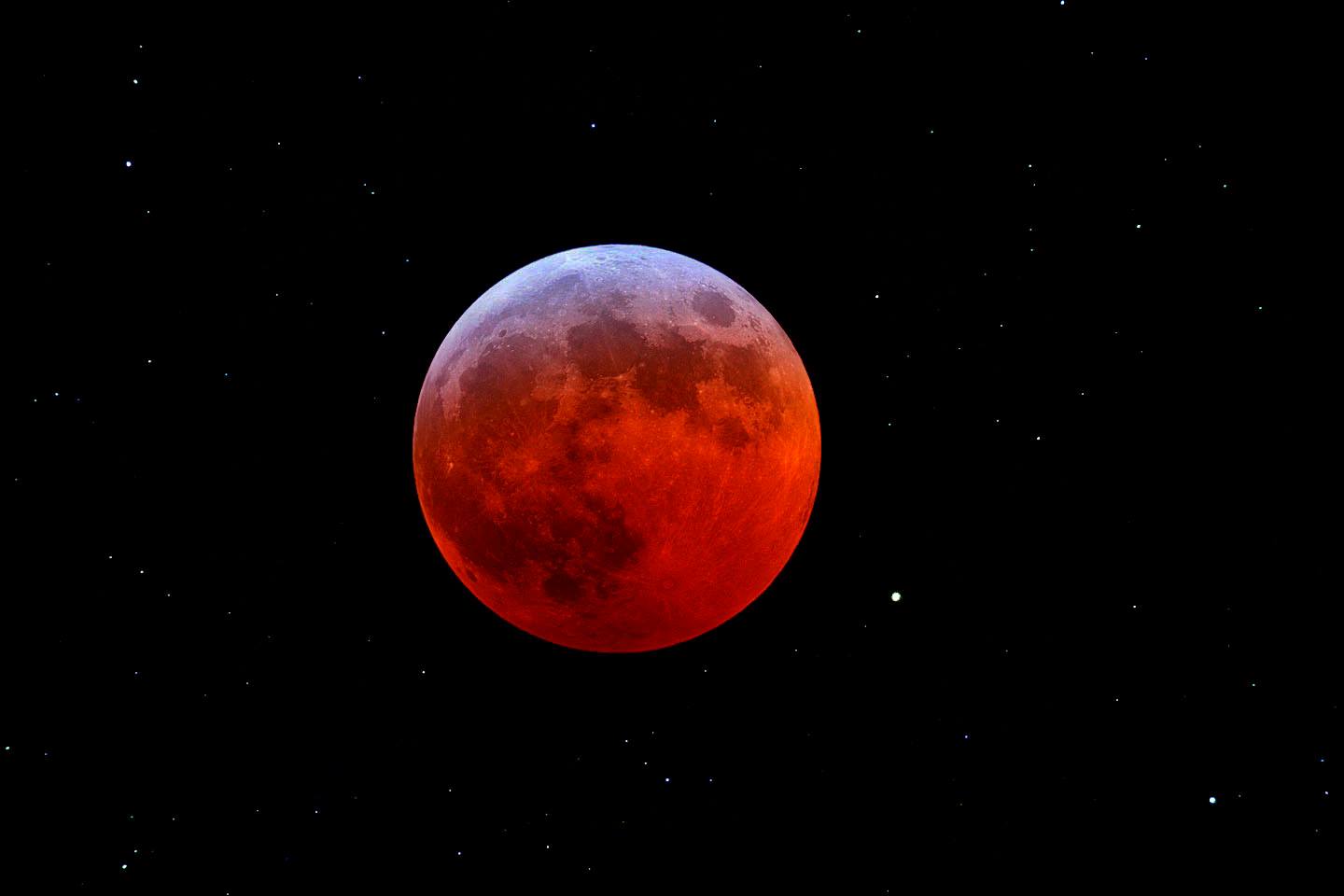
Arie Pier Nagel (The Netherlands) used a 11 cm APO and Canon 400D, moon about 2 sec exposed and stars 20 sec. ISO 400.
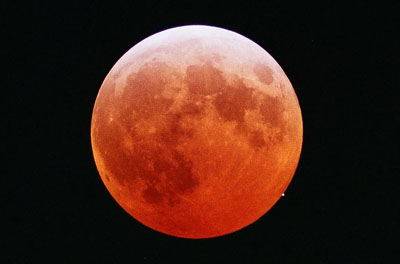
Jörgen Blom caught the 6th-magnitude star 56 Leonis coming out from behind the fully eclipsed Moon four minutes past midnight in Stockholm, Sweden. Photo details: 4" Vixen refractor at f/9.8, 10 seconds exposure on negative ISO 800 film.
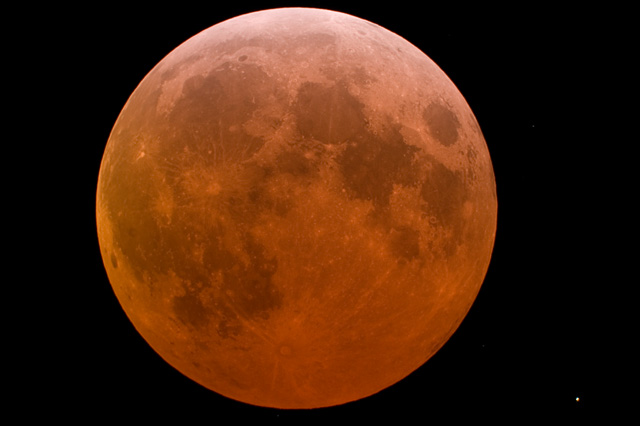
Photo: Marco Verstraaten (Twisk, The Netherlands).
C11 f6,3 en een Nikon D70. 13 sec exposure at ISO 200.
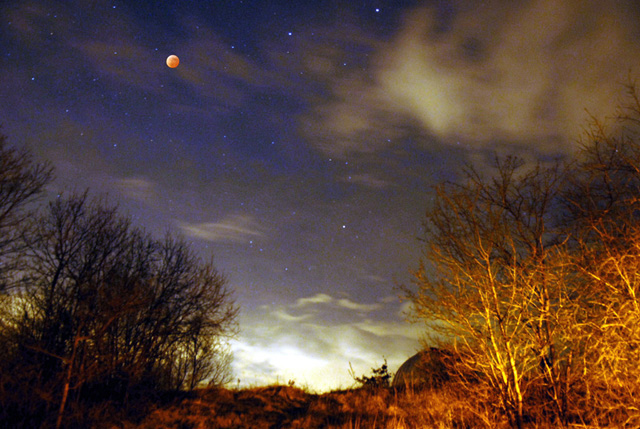
Copernicus Public Observatory (Overveen, The Netherlands) at mid-totality.
Photo: Carl Koppeschaar, Nikon D200 f2.8/55mm 13 sec exposure at ISO 400.
Photo's: Henk Bril (Nieuwstadt, The Netherlands).
Canon 350d behind a Takahashi Sky90 refractor.
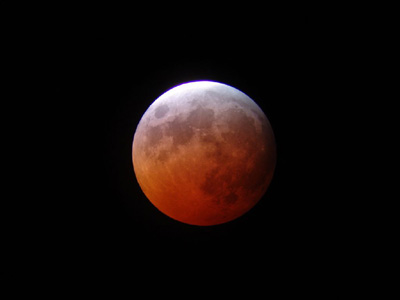
Victor van Wulfen observed and photographed at Copernicus Public Observatory.
More images at Clearskies.nl
Beautiful photographs could be made by holding a small digital camera behind the eyepieve of the telescope.
Photographs: Carl Koppeschaar.
Totality was best observed with binoculars.
Photographs: Carl Koppeschaar.
One of your heroes of the evening: Norbert Schmidt, who did the live webcast
from Copernicus Public Observatory.
Photographs: Carl Koppeschaar.
Some observers used stunning equipment.
Photo: Carl Koppeschaar.
Photo Galleries:
WEBCAST
Other webcasts:
- Sterrenkids (Netherlands)
- Astroversum (Netherlands)
- Lunar Observers (Birmingham, UK)
- AstroCam (Cambridgeshire, UK)
- Runar Sandnes (Reed, Norway)
- Carsten Arnholm (Heggedal, Norway)
- MoFi2007 Live (Germany)
- High Moon (Switzerland)
- Universidad Complutense de Madrid (Madrid, Spain)
- Serviastro (Barcelona, Spain - English webpage)
- Saros.org (Gran Canaria, Canary Islands)
- SEMS/The University of North Dakota (Rome, Italy)
- Unione Astrofili Italiani (Firenze and Catania, Italy)
- ParsSky.net (Iran)
- HRC K1 Observatory Team (Isfahan, Iran)
- Iran Night Sky (Iran)
- Associación Argentina "Amigos de la Astronomía" (Argentina)
- Coca-Cola Space Science Center (Georgia, USA)
THE ECLIPSE
Copper Moon
A lunar eclipse occurs when the Full Moon passes through the Earth's shadow.
The Moon encountered the penumbra, the Earth's outermost shadow zone, at 20:18 Universal
Time (UT). About thirty minutes later a slight dusky shading could be noticed on the
leading edge of the Moon.
At 21:30 UT the Moon began its entry into the innermost shadow zone, or umbra.
For more than an hour a circular shadow creeped across the Moon's face.
At 22:44 UT, the Moon was completely within Earth's dark shadow. It then took on
an eerie coppery tint that could be compared with the colour of blood.

During a total eclipse the Moon shines with a orange reddish glow.
Photograph: Robert Smallegange (Leeuwarden, The Netherlands). |
Without Earth's atmosphere, the Moon would disappear completely once immersed in
the umbra. Longer wavelengths of light penetrate Earth's atmosphere better than
shorter wavelengths, which is why the rising or setting sun looks reddish. In
essence, the ruddy tint of a totally eclipsed moon comes from the ring of
atmosphere around Earth's limb that scatters a sunset-like glow into the umbra.
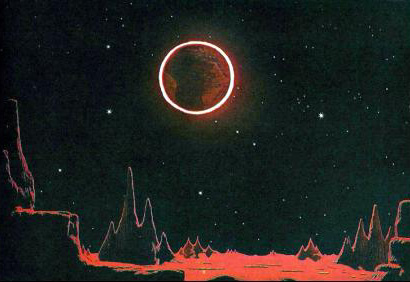
During totality a ring of reddish sunlight surrounds the Earth. |
The hue actually changes from one eclipse to another, ranging from a bright coppery
orange to brownish. The Moon may darken so much that it becomes all but invisible
to the unaided eye. These very dark lunar eclipses often occur after exceptional
volcanic eruptions.
Totality ended at 23:58 UT, when the moon's leading edge exitted the umbra.
The moon left the umbra completely at 01:11 UT, and the eclipse ended
at 02:23 UT when the moon made its last contact with the penumbra.
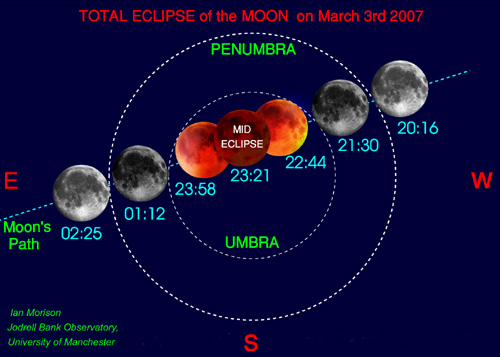
Path of the Moon through Earth's umbral and penumbral
shadows during the Total Lunar Eclipse of March 3-4, 2007. Times in UT.
Courtesy: Ian Morison, Jodrell Bank Observatory, University of Manchester.
|
Crater timings
In 1702, Pierre de La Hire made a curious observation about Earth's
umbra. In order to accurately predict the duration of a lunar eclipse,
he found it necessary to increase the radius of the shadow about 2% larger
than warranted by geometric considerations. Although the effect is
clearly related to Earth's atmosphere, it's not completely understood
since the shadow enlargement seems to vary from one eclipse to the next.
The enlargement can be measured through careful timings of lunar craters
as they enter and exit the umbra. Such observations are best made using a
low-power telescope and a clock or watch synchronized with radio time
signals. Timings should be made to a precision of 0.1 minute. The basic
idea is to record the instant when the most abrupt gradient at the umbra's
edge crosses the apparent centre of the crater. In the case of
large craters like Tycho and Copernicus, it's recommended that you
record the times when the shadow touches the two opposite edges of
the crater. The average of these times is equal to the instant of
crater bisection.
Here could be found predictions for the immersions and emersions of craters, mountains
and a small mare on the Moon.
Occultations
An occultations (total and grazing) of fifth magnitude star 59 Leonis occurred during the
total lunar eclipse.
Next lunar eclipse
This year will see another total lunar eclipse on August 28. This eclipse will be
partly visible from the Americas, completly visible from Oceania en partly visible from Australia and Asia.
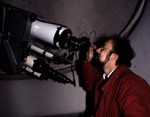
By Carl Koppeschaar
FURTHER INFORMATION
March 3-4, 2007 total lunar eclipse:
General information:
Previous webcasts organized by Astronet:
- Mercury transit, May 7, 2003
- Total lunar eclipse, May 15-16, 2003
- Annular solar eclipse, May 31, 2003
- Total lunar eclipse, November 8-9, 2003
- Total lunar eclipse, May 4,2004
- Totale lunar eclipes, October 28, 2004
- Venus transit, June 8, 2004
- Solar eclipse, March 29, 2006 (Dutch only)











